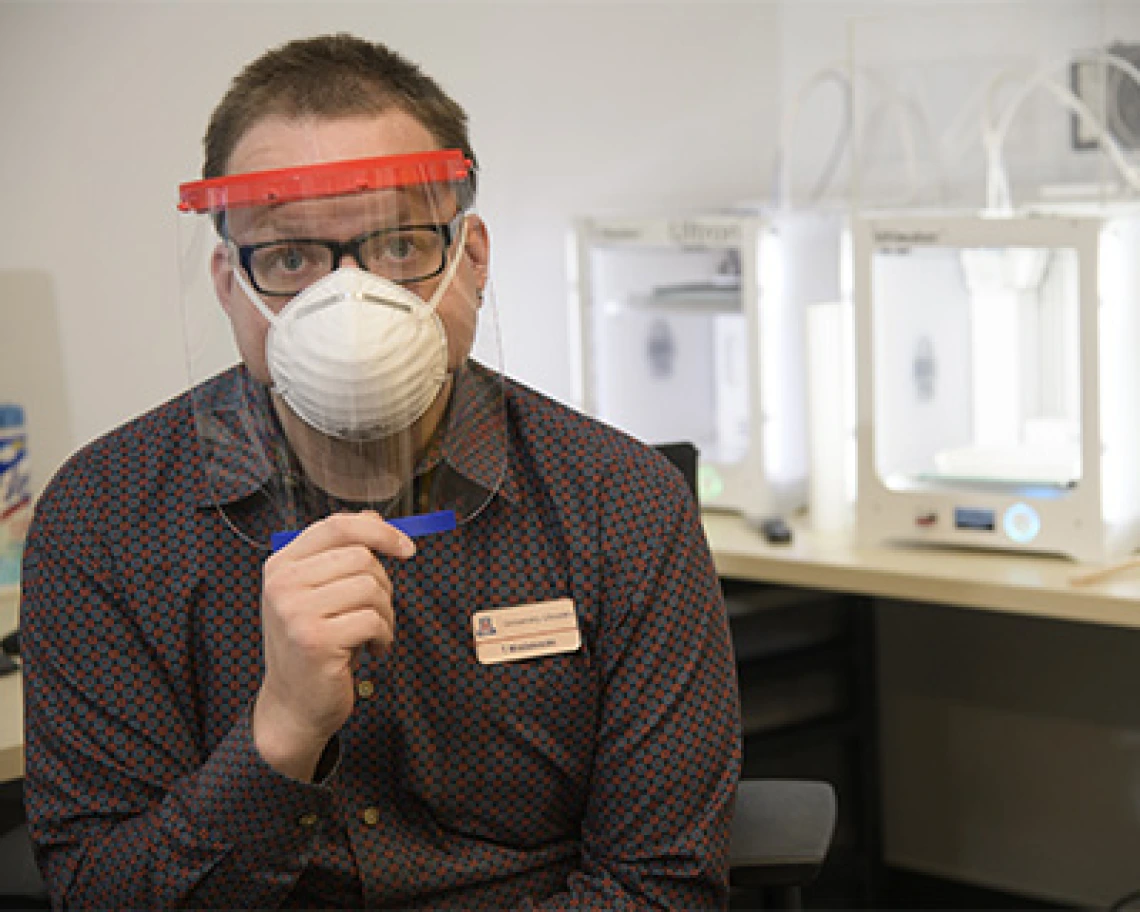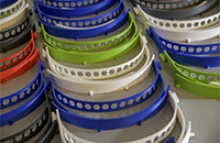UArizona Health Sciences Connects Arizona’s Makerspaces in COVID-19 Response
A network formed to support the University of Arizona Health Sciences Design Program proves invaluable in uniting the state’s makerspaces – collaborative workspaces with a variety of high- and low-technology tools for making, learning, exploring and shari

As initial responses to the COVID-19 pandemic began to unfold, Kasi Kiehlbaugh, PhD, director of the University of Arizona Health Sciences Design Program, noticed a trend that was uplifting and concerning at the same time. Across the university, researchers and scientists were mobilizing quickly to find solutions to the critical shortage of equipment needed by health care workers on the front lines, but those efforts were mostly uncoordinated.

Tory Middlebrooks, of University Libraries, models a face shield, which is designed to be worn in conjunction with addition PPE such as a mask. Middlebrooks mans the 3D printers that produced the headbands for the face shield. (Photo: Kris Hanning, University of Arizona Health Sciences)
“There were multiple efforts across campus in parallel, but nobody was talking to each other,” said Dr. Kiehlbaugh. “It became clear pretty quickly that everyone needed to begin moving toward the most optimal designs together instead of working in isolation.”

Kasi Kiehlbaugh developed the AZ Makers Fighting COVID-19 group to connect people in makerspaces across the state in their efforts to find solutions to the critical shortage of equipment needed by health care workers on the front lines. (Photo: University of Arizona Health Sciences)
Most of the efforts revolved around the technology available in makerspaces, which are collaborative workspaces containing a variety of tools for making, learning, exploring and sharing. Laser cutters, 3-D printers, computer numerical control routers and mills, and even sewing machines could potentially be utilized to fabricate much-needed personal protection equipment for medical professionals and parts for the ventilators that keep COVID-19 patients alive.
And when it came to identifying and connecting UArizona makerspaces, Dr. Kiehlbaugh, who holds a teaching appointment in the College of Engineering Department of Biomedical Engineering, had an edge.
“I had been working to build a university-wide network of people who had these types of spaces so that we could connect the new Health Sciences Design program makerspace into the broader campus community,” she said. “When the coronavirus crisis emerged, I seized the opportunity to leverage the work I had been doing around building a network to mobilize them to do this specific work.”

A face shield headband is produced on a 3D printer. (Photo: Kris Hanning, University of Arizona Health Sciences)
Kiehlbaugh chose the instant messaging platform Slack as a virtual meeting hub and set up the AZ Makers Fighting COVID-19 group. Using her existing network of campus contacts, she initially invited about 50 people from UArizona. The scope soon broadened to include any entity with a community makerspace, including Arizona State University, Northern Arizona University, community colleges and non-profit community makerspace representatives such as Xerocraft, as well as medical groups such as Carondelet Health Network. Now, more than 110 people are active participants in the AZ Makers group.
One of the group’s early success stories is a supporting a collaboration between Banner – University Medical Center and the Catalyst Studios at University Libraries that has resulted in face shields being produced and delivered to Banner locations in Phoenix. Another team of faculty and staff from the School of Information, the College of Architecture, Planning and Landscape Architecture, and Xerocraft is designing and testing a new face shield design. Several groups are working on mask designs and 3-D printing prototypes for testing, while others are developing prototypes for ventilators and ventilator parts.

These headbands, produced by 3D printers in Tucson, where then shipped to Phoenix to be assembled into face shields and distributed to Banner employees. (Photo: Kris Hanning, University of Arizona Health Sciences)
“In a very short period of time, we have developed a rapid prototyping and iteration process, and we are bringing in experts to give feedback from the clinical-use perspective,” said Dr. Kiehlbaugh, who hopes to gain more involvement from Arizona’s hospital networks, especially rural and critical care hospitals, in the coming days.
The AZ Makers Fighting COVID-19 group is quickly making an impact in the state’s response to the COVID-19 pandemic. But even when the pandemic is over, there are benefits to be gained, especially for UArizona Health Sciences students, according to Dr. Kiehlbaugh.
“The Health Sciences Design program is a new initiative to develop a program that offers credit-bearing courses for students to come learn the design thinking process in the context of health care challenges. This kind of real-time development of personal protective equipment is a beautiful example of that process in action,” she said. “While I'm not teaching a formal course right now, the process that is being used to facilitate all this is precisely what we will be teaching our students in that program.”
The UArizona Health Sciences COVID-19 Resources webpage can be found here.
For the latest on the University of Arizona response to the novel coronavirus, visit the university's COVID-19 webpage.
###
NOTE: Photos available upon request.
This story originally appeared on the UArizona Health Sciences Connect webpage.
About the University of Arizona Health Sciences
The University of Arizona Health Sciences is the statewide leader in biomedical research and health professions training. UArizona Health Sciences includes the Colleges of Medicine (Tucson and Phoenix), Nursing, Pharmacy, and the Mel and Enid Zuckerman College of Public Health, with main campus locations in Tucson and the Phoenix Biomedical Campus in downtown Phoenix. From these vantage points, Health Sciences reaches across the state of Arizona, the greater Southwest and around the world to provide next-generation education, research and outreach. A major economic engine, Health Sciences employs nearly 5,000 people, has approximately 4,000 students and 900 faculty members, and garners $200 million in research grants and contracts annually. For more information: uahs.arizona.edu (Follow us: Facebook | Twitter | YouTube | LinkedIn | Instagram).

